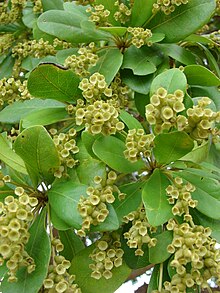Black olive tree
| Black olive tree | ||||||||||||
|---|---|---|---|---|---|---|---|---|---|---|---|---|

Black olive tree ( Bucida buceras ) |
||||||||||||
| Systematics | ||||||||||||
|
||||||||||||
| Scientific name | ||||||||||||
| Bucida buceras | ||||||||||||
| L. |
The so-called black olive tree ( Bucida buceras ) is a species of the genus Bucida of the winged family (Combretaceae). It is common in the Neotropics . - The German name is a translation from English (black olive tree). Since there is no resemblance to olive trees, the reason for this vulgar name remains unclear.
Description and ecology
Appearance and leaf
This species grows as an evergreen tree and reaches heights of mostly 20, rarely, under favorable conditions as a forest tree even 30 meters and a maximum trunk diameter of 1 to 1.8 meters. The bark is gray-brown to brown, very thin in small trees (1.2 to 2.2 centimeters) and only becomes thick, cracked and scaly in old trees. The tree is usually evergreen, it can only lose its leaves during long dry periods.
The alternate short at the tips, upright branches arranged leaves are divided into petiole and leaf blade. The somewhat hairy petiole is 6 to 18 millimeters long. The entire leaf blade is 2.5 to 7.5 centimeters long and 1.5 to 5 centimeters wide and elliptical to rounded and is widest above the center. The spreader tip can have a short tip or can be notched. The top of the leaf is green and the underside is yellow-green. The leaf surface is initially hairy and later glabrous.
Inflorescence and flower
The tree is in bloom practically all year round. The flowers are on finely hairy, gray-green, spike-like inflorescences that grow from the base of the younger leaves. The flowers are hermaphroditic or purely male. The hermaphroditic flowers are protogynous . The sessile flowers are 6 to 9 millimeters long and 6 to 12 millimeters wide and five-fold. The flower cup is brownish. Petals are missing. The disc and calyx are five-toothed, the calyx is somewhat hairy. There are two circles with five stamens each. The stamp has a einfächerigen ovary . The styles are slender and hairy.
Fruit and seeds
The hard, only 3 millimeters long, pentagonal stone fruits that contain only one seed. The pericarp is dry or slightly fleshy. The thousand grain weight is around 26 g. The fruits can gall mites are a parasite and form ox horn curved bile from which almost 10 millimeters can be long. An English common name is therefore also "Oxhorn bucida".
Occurrence
The tree is widespread from southern Mexico through Central America to Panama and on the Caribbean islands of Cuba , Hispaniola , Puerto Rico , Jamaica , the Bahamas and the Lesser Antilles , on the Caribbean coast of Colombia, on the coasts of Venezuela and Guyana . It usually grows near the coast, mostly on dry, often salty sites, in Central America also at altitudes of several hundred meters.
In South Florida it was introduced by humans as a street and park tree.
Taxonomy
Bucida buceras was first published in 1759 by Carl von Linné in Systema Naturae, Editio Decima 2: 1025. Synonyms for Bucida buceras L. are: Bucida wigginsiana Miranda , Myrobalanus buceras (L.) Kuntze , Terminalia buceras (L.) C. Wright .
There is currently a tendency to abandon the genus Bucida and place it with Terminalia .
use
The wood is hard, heavy, durable and termite-resistant and is used in shipbuilding and bridge construction, for the production of floorboards, fence posts, gates and workbenches, as well as for the extraction of charcoal.
Because of its insensitivity to drought, wind and salt water spray, the tree is planted as a shady street, park and garden tree, especially in Florida and on the Caribbean islands.
literature
- Peter Schütt, Horst Weisgerber, Hans J. Schuck, Ulla Lang, Bernd Stimm, Andreas Roloff : Trees of the tropics. Nikol, Hamburg 2006, ISBN 3-933203-79-1 . Pp. 161-165
Web links
Individual evidence
- ^ Bucida buceras at Tropicos.org. Missouri Botanical Garden, St. Louis, accessed on April 2, 2015.
- ^ Terminalia buceras Plants of the World Online. Retrieved March 17, 2018
